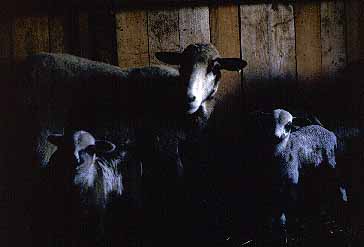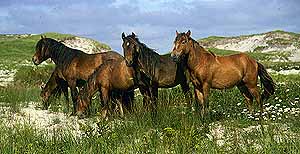Agroecosystem Topics Page | Agroecosystems Home Page | Site Contents
Livestock Genetic Diversity

|
Navajo SheepThe Novajo Sheep is one of the endangered breeds of livestock in North America. Important for their wool and meat, the Navajo Sheep had declined to a critical population size. Now the sheep are being reintroduced into Native People's lands. In 1994 the population number was 543 and it continues to increase (Scherf, 1995). |
Prepared by Troy Young
(1998)
CONTENTS
- Overview
- Some Key facts and Figures
- Important Terms
- Useful Literature
- Useful Links
- Cited Literature and Links
Back to Agroecosystems Home Page
Overview
Domestication of livestock began some 14 thousand years ago in the Near East and Southern Asia. Once domesticated, the use of these animals spread throughout the world. A population of over ten billion chickens makes it the most numerous domesticated animal of the world. Cattle are second and sheep, pigs and goats follow respectively (Heiser, 1990). The number of breeds tend to be a function of human population and land area. Conditions which support human population growth also benefit diversification of breeds (Hall and Ruane, 1993).
In this century, About 4000 various breeds of domesticated livestock have been used by humans. Of that total, more than 618 breeds are now extinct and over 475 of the remaining breeds are classified as critical. By the turn of the century, at least 100 wild animal species per day may be faced with extinction. Many of these vanishing wild species could contribute additional diversity to domestic breeds for the food and agriculture of humankind in the future (Scherf, 1990).
In the developing world, breed substitution and cross breeding of native breeds with western livestock to increase production under western type livestock systems has led to many of the world's most robust breeds of farm animals becoming endangered and to the loss of several native species (Concar, 1992). Larger milk yields, bigger litters and leaner meats are just a few characteristics sought after, as farmers shift from subsistence farming to cash farming due to economic pressures. Even the transition from draught to mechanical power with the advance of technology has resulted in a vast decrease in genetic variation as many native draught species were displaced (de Haan et. al., 1997).
Narrowing of the genetic variation associated with greatly reduced population size reduces the ability of local breeds to respond to environmental change, disease and other stresses.
Currently there is no answer to the question of how much genetic diversity the world can safely lose. Not all of the different livestock populations must necessarily be conserved, as many may exhibit little genetic variability. A system needs to be developed that would allow us to identify and maintain the minimum number of genotypes required for a breed able to adapt to changing conditions in the future (de Haan, et. al., 1997).
How can we reduce the loss of breeds and of genetic diversity within breeds? Some important means are:
- Importation of exotic species as livestock or as pets - by keeping potbellied pigs, ostriches and even emu as pets or alternative livestock, we are retaining some of the biodiversity that might have otherwise been lost. However, it should be noted that loss of genetic variation could result if these new exotic species manage to breed with native stocks.
- Instead of selecting livestock for maximum production under "optimal" conditions and altering the environment to provide those conditions, we need to select breeds that will perform well under existing or more natural environmental conditions.
- We can freeze ova, sperm and embryos for later use.
Which ever method is used, we must ensure that livestock biodiversity is not reduced much farther than it already has been.

Scottish Highlanders
Scottish Highlanders are becoming a popular breed in Canada, and are an example of selecting livestock that survive well under local conditions -they thrive where other breeds are not very productive or couldn't even survive.
Key facts and figures
Table 1: Number of rare and extinct breeds and their continent of origin. Source: Hall and Ruane, 1993)
| CONTINENT OF ORIGIN |
NUMBER OF RARE AND EXTINCT BREEDS |
| Africa |
|
| Asia |
|
| Europe |
|
| North & Central America |
|
| South America |
|
| Oceania |
|
| ex. U.S.S.R. |
|
| World Total |
|
Table 2. Examples of numbers breeds of different types of livestock that are "at risk" (numbers place them in critical or endangered category). Source: Scherf, 1995.
| TYPE |
OF BREEDS |
NUMBER OF BREEDS AT RISK |
| Ass |
|
|
| Bactrian Camel |
|
|
| Dromedary |
|
|
| Cattle |
|
|
| Goat |
|
|
| Pig |
|
|
| Sheep |
|
|
| Chicken |
|
|
| Duck |
|
|
| Goose |
|
|
| Ostrich |
|
|
| Turkey |
|
|
Table 3: Endangered livestock of Canada and population sizes.
Source: Scherf, 1995.
| BREED | POPULATION SIZE |
| Canadian Cattle |
|
| Canadian Horse |
|
| Lac La Croix Indian Pony |
|
| Newfoundland Pony |
|
| Sable Island Horse* |
|
| Lacombe Pig |
|
| Newfoundland Sheep |
|
| Black Welsh Mountain Sheep |
|
| Canadian Arcott Sheep |
|
| Canadian Corriedale Sheep |
|
| DLS Sheep |
|
| Outaouais Arcott Sheep |
|
| Rideau Arcott Sheep |
|
| St. Croix Sheep |
|
 *The Sable Island Horse shown at right is probably of French Acadian origin. It
was introduced to Sable Island off of the coast of Nova Scotia, Canada,
250 or more years ago. It survives as a wild or "feral" population, subject to intense natural selection. The horses
feed on dune vegetation. Photo courtesy of Zoe Lucas.
*The Sable Island Horse shown at right is probably of French Acadian origin. It
was introduced to Sable Island off of the coast of Nova Scotia, Canada,
250 or more years ago. It survives as a wild or "feral" population, subject to intense natural selection. The horses
feed on dune vegetation. Photo courtesy of Zoe Lucas.
Important terms
Definitions were extracted from Scherf (1995)
- Breed
- Animals that through selection and breeding have come to resemble one another and pass those traits uniformly to their offspring.
- Population
- All the animals within a breed, variety or strain. An interbreeding group.
- Domesticated
- Animals which breed under the control of humans.
- Endangered
- Breed is endangered when the total number of breeding females in between 100 and 1000 or the total number of breeding males is less than or equal to 20 and greater than 5.
- Critical
- Breed is critical when the total number of breeding females is less than 100 or the total number of breeding males is less than 5.
- Extinct
- Breed is extinct when it is no longer possible to easily recreate the breeding population.
- 'In Situ' conservation
- Stock is preserved by protecting the ecosystem in which it occurs naturally, by the establishment and maintenance of national parks and reserves, where natural selection is allowed to continue
- 'Ex Situ' conservation
- (a)The conservation of whole animal maintained in captive populations in zoos; (b) the conservation of parts of animal by freezing ova, sperm and embryos, cryopreserving the gene pool for future use.
Useful literature
-
Agriculture Canada. 1989. Animal Breeding - Recent Advances and Future Prospects. Canadian Government Publishing. Supply and Services Canada, Ottawa.
-
Feron, E.M.. 1995. New Food Sources; Conservation of Biodiversity and Sustainable Development: Can unconventional animal species contribute to feeding the world?. Biodiversity Conservation 4:233-240.
-
Hall, Stephen J.G., and Daniel G. Bradley. 1995. Conserving Livestock Breed Diversity. Trends in Ecology and Evolution 10: :267-270.
-
Scherf, B.D. (ed). 1995. World Watch List For Domestic Animal Diversity. Food and Agriculture Organization of the United Nations, Rome.
Useful links
- ALTERNATIVE &
EXOTIC LIVESTOCK
(http://www.valleystables-exotics.com/) Valley Stables & Exotic Alternative Livestock, Spons. (Viewed 1 Feb. 2001) - BREEDS OF
LIVESTOCK
(http://www.ansi.okstate.edu/breeds/) Department of Animal Science - Oklahoma State University,. Spons. (1995, February 22; Viewed 1 Feb. 2001) - LIVESTOCK WORLD
EXOTIC ANIMALS
(http://www.pitchfork.com/exotics.htm) Livestock World, Spons. (1995; Viewed 1 Feb. 2001) - POPULATION GENETICS AND ANIMAL BREEDING
(http://www.boku.ac.at/nuwi/popgen/) Universitaet fuer Bodenkultur Wien, University of Agricultural Sciences Vienna, Spons. (2000, June 6; Viewed 1 Feb. 2001) - PRIORITY BREEDS OF CANADA
(http://www.trentu.ca/rarebreedscanada/prioritylist.htm). Rare Breeds Canada, Spons. (Viewed 14 Apr. 2002)
Cited Literature and Links
- Concar, David. 1992. Push for Productivity Kills Third World Breeds. New Scientist 1: 16.
- de Haan, Cees, H. Steinfeld, and H. Blackburn. 1997. Livestock and the Environment - Finding a Balance. European Commission Directorate - General for Development, Development Policy Sustainable Development and Natural Resources.
- Hall, Stephen J.G., and J. Raune. 1993. Livestock Breeds and Their Conservation: A Global Review. Conservation Biology , volume 7, no. 4:815-825.
- Heiser, Charles B. Jr. 1990. Seed to Civilization - the story of food. Harvard University Press. Massachusetts.
- Scherf, B.D. (ed). 1995. World Watch List For Domestic Animal Diversity. Food and Agriculture Organization of the United Nations, Rome.